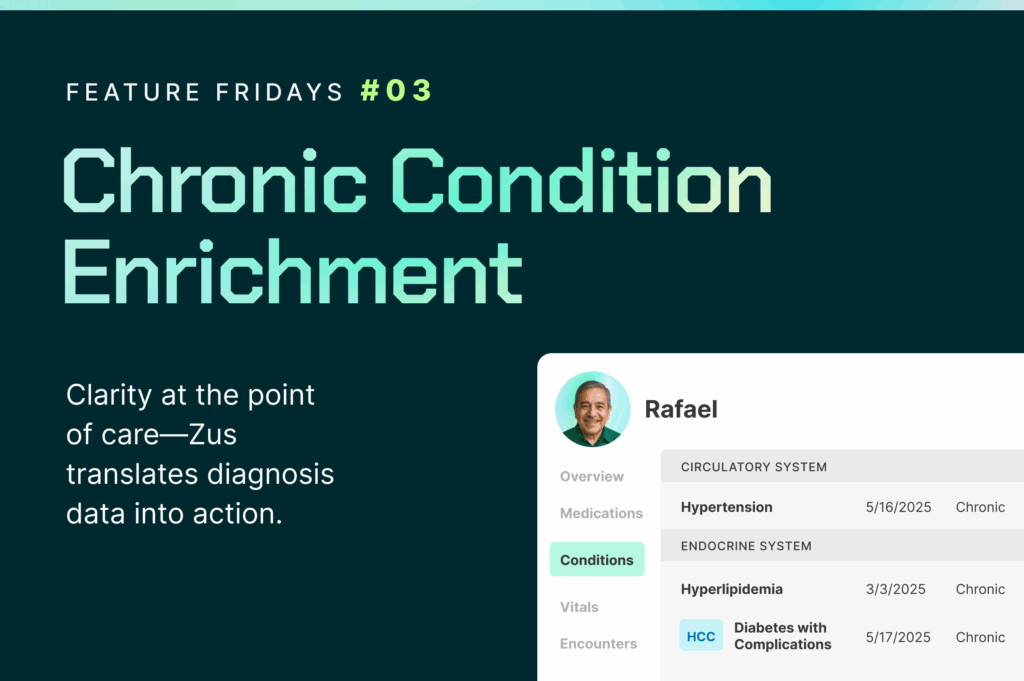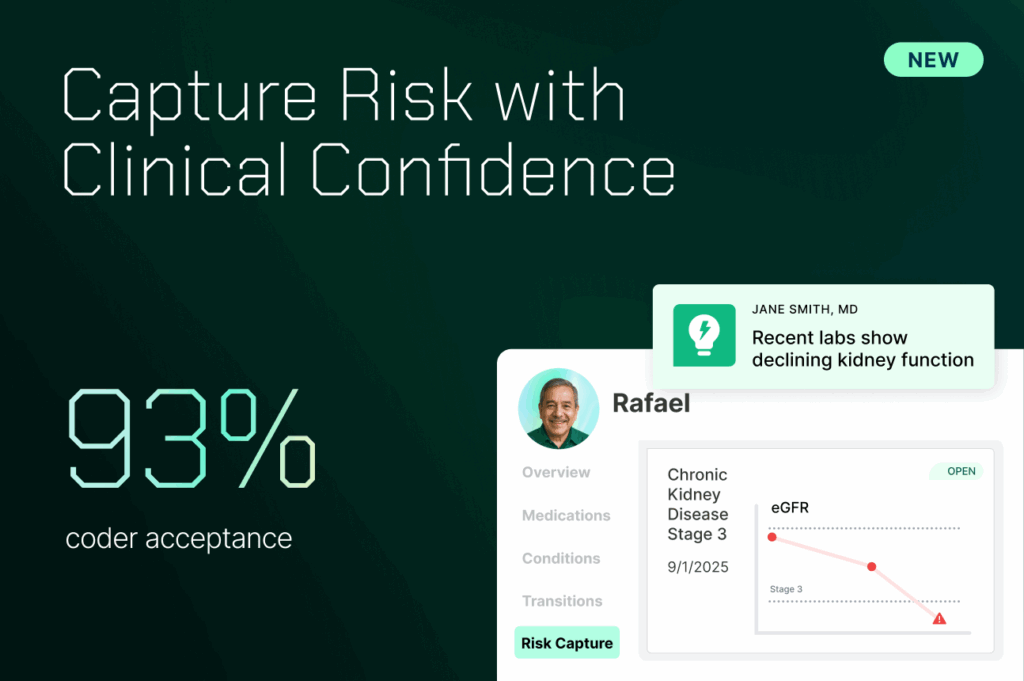The question: How many ICD-10 (International Classification of Diseases-10th Revision) codes exist for hyperlipidemia, or high cholesterol?
The answer: three.
E78.4 (Other hyperlipidemia).
E78.49 (Other specified hyperlipidemia).
And E78.5 (Hyperlipidemia, unspecified).
That’s three different codes for essentially the same condition. And one of them isn’t even billable.
Now imagine multiplying that complexity across hundreds of conditions and multiple coding systems. That’s the reality care teams face every day. Spending hours decoding messy data instead of focusing on patient care.
That’s why we built Condition Enrichment to normalize, group, and tag diagnoses across every condition in your population.
And because chronic conditions matter most in value-based care, today’s Feature Friday is all about Chronic Condition Enrichment –turning coding confusion into clarity so care teams can act fast on what matters most.
Why this matters:
If you’re a care team managing quality measures or value-based contracts, your job depends on knowing what’s really going on with your patients. You need a clear picture of their chronic conditions – diabetes, high cholesterol, heart failure- and the ability to act fast when something needs attention.
Sounds simple, right? But here’s a reality check.
Most clinical systems speak in code. Literally. Diagnosis data lives in dozens of formats – ICD-9, ICD-10, SNOMED, HCC, CCI, CCSR – and none of them speak the same language.
And then there’s duplication. We already discussed hyperlipidemia. Three codes, all pointing to the same underlying issue: elevated cholesterol.
Diabetes with complications? That could appear as E10.65 (Type 1 diabetes with hyperglycemia) or E11.65 (Type 2 diabetes with hyperglycemia), depending on the encounter.
Behind the scenes, diagnoses might also live under:
- ICD-9 (International Classification of Diseases, 9th Revision): older formats still found in legacy records
- SNOMED (Systematized Nomenclature of Medicine – Clinical Terms): clinician-friendly terms used in EHRs
- HCC (Hierarchical Condition Category codes): risk adjustment tags tied to value-based payments
- CCI (Chronic Condition Indicator) and CCSR (Clinical Classifications Software Refined): ways to group conditions into categories for analysis
(Flashback to our last Pipe Dreams blog. Interoperability can feel like alphabet soup. Download our cheat sheet designed just for here.)
Every format is slightly different. Most aren’t even readable unless you’re a data analyst.
So when you want to answer simple questions like:
- Who has diabetes?
- Who has congestive heart failure with complications?
- Which patients fall into risk groups covered by our contract in value-based care?
–you end up buried in code. What should take seconds turns into a SQL-heavy project or a manual scramble.
Chronic Condition Enrichment changes that.
What this feature does:
Condition Enrichment works for all conditions – acute and/or chronic – but it’s especially powerful for managing complex long-term conditions that drive cost and quality measures.
Here’s how Chronic Condition Enrichment solves the problem:
- Normalizes messy diagnosis codes: It translates multiple diagnosis code formats into a single, standardized view, so that your team only sees one clean coherent record instead of juggling different coding systems.
- Converts old codes into modern ones: If we see an old ICD-9 code that clearly maps to ICD-10, we’ll convert it—so you’re not missing patients because they were diagnosed 8 years ago.
- Adds smart tags and categories: We enrich the diagnosis data by tagging it with standardized groupings that make the information easier to use – whether you’re filtering for outreach, building reports, or managing risk-based contracts. These groupings include:
- CCI (Chronic Condition Indicator): Flags whether a diagnosis represents a chronic condition, helpful for identifying long-term conditions like hypertension or diabetes.
- CCSR (Clinical Classifications Software Refined): Groups related diagnoses into clinically meaningful categories and body system groupings (e.g., all Endocrine disorders, so diabetes and hyperlipidemia appear together) helping teams act on patterns, not just codes.
- HCC (Hierarchical Condition Categories): Flags risk-related diagnoses for value-based care, using CMS and HHS HCC models to identify conditions that impact risk adjustment and reimbursement.
Check out this demo to see how it works in action.
Why you should care
Remember our high cholesterol example? Those three ICD-10 codes for hyperlipidemia collapse into one clear term in the Zus Aggregated Profile (ZAP): Hyperlipidemia.
Diabetes with complications? It’s grouped under Endocrine, Nutritional, and Metabolic Disorders, right alongside related conditions like hyperlipidemia giving you a complete picture in seconds.
And don’t worry: Zus never overwrites the original codes. We simply add enriched groupings, mappings, and standardized values alongside them, clearly marked so you always know what came from the source and what Zus added.
And our coverage is extensive, so you don’t miss a thing:
- SNOMED: Covers 99% of clinical concepts you’d find in EHR problem lists, all mapped and normalized for easy use.
- ICD-10: Captures and standardizes 89% of U.S. billing codes, ensuring financial and clinical workflows stay aligned.
- CCI: Flags 77% of chronic conditions, making long-term care populations easy to identify.
- CCSR: Groups 94% of diagnoses into meaningful clinical categories and body system groupings, so you can quickly spot patterns across systems like Endocrine, Cardiovascular, or Mental Health.
The result? A single, clear view of every condition, no matter how many codes or systems are behind it. One record. One language. One less thing slowing you down.
And because it’s fully integrated into Zus Data Marts, those enrichments aren’t just visible they’re queryable. Population analytics, cohort building, and outreach planning just got a lot easier.
👀 Spoiler alert: next week’s Feature Friday is all about Data Marts.
📍 Want to see how this works in your population? Book a demo we’ll show you how to turn condition chaos into clinical clarity and improved care for your patients.




